|By Liping Yang, Senior Manager, Academic Publishing, and Emma Harris, Associate Editor, Gale Primary Sources|
Gale Primary Sources’ State Papers Online Colonial: Asia digital archive welcomed its third instalment in September 2024 – State Papers Online Colonial: Asia, Part III: Malay States, Malaya, and Straits Settlements – providing a continuation of and perfect complement to Part II through a thematic collection on the history of West Malaysia and the earlier history of Singapore.
Made up of mostly original correspondence, as well as two series of maps and plans, and a series of historical photographs, Part III contains over 625,000 newly scanned pages from twelve Colonial Office series sourced from The National Archives, UK.
Historical Context
From the early nineteenth century to the 1940s, there existed four different types of British colonial or controlled territories, in parallel or succession, on the Malay Peninsula and the island of Singapore: the Straits Settlements, the Federated and the Unfederated Malay States, and the Malayan Union.
Consisting of Penang, Dinding, Malacca, and Singapore, the Straits Settlements was established in 1826 by the British East India Company, and then came under British Raj control in 1858. In 1867, it was brought under direct British control as a Crown colony. Following the end of WWII, the colony was dissolved in 1946.

The Federated and the Unfederated Malay States were British protectorates with their own local rulers. The Federated Malay States consisted of four British protected states in present-day West Malaysia: Negeri Sembilan, Selangor, Pahang, and Perak, from 1895 to 1946. In these states, power was in the hands of the four local British Residents and the Resident-General, whilst discretionary powers of the sultans were reduced mostly to religion and customs. Together with Malacca and Penang, the Malay states established the Malayan Union.
The Malayan Union was replaced by the Federation of Malaya in 1948, and the latter became independent in 1957. Malaysia was founded in 1963 when Malaya united with Singapore, North Borneo (Sabah), and Sarawak. Singapore was expelled in 1965, leaving the original states of Malaya, Sarawak, and Sabah to make up modern-day Malaysia.
Japanese Occupation
Malaysia and Singapore were occupied by the Japanese imperial army during 1941–1945. There are many files in Part III on the topic of Japanese occupation, including CO 273/669/1, which contains over 300 pages of fortnightly reports and documents detailing the conditions of the Straits Settlements during this period. Events covered include Japan’s decision to transfer four Malay states – Perlis, Kedah, Kelantan, and Terengganu – back to Siam (Thailand), which were originally signed over to the UK under the Anglo-Siamese Treaty of 1909.
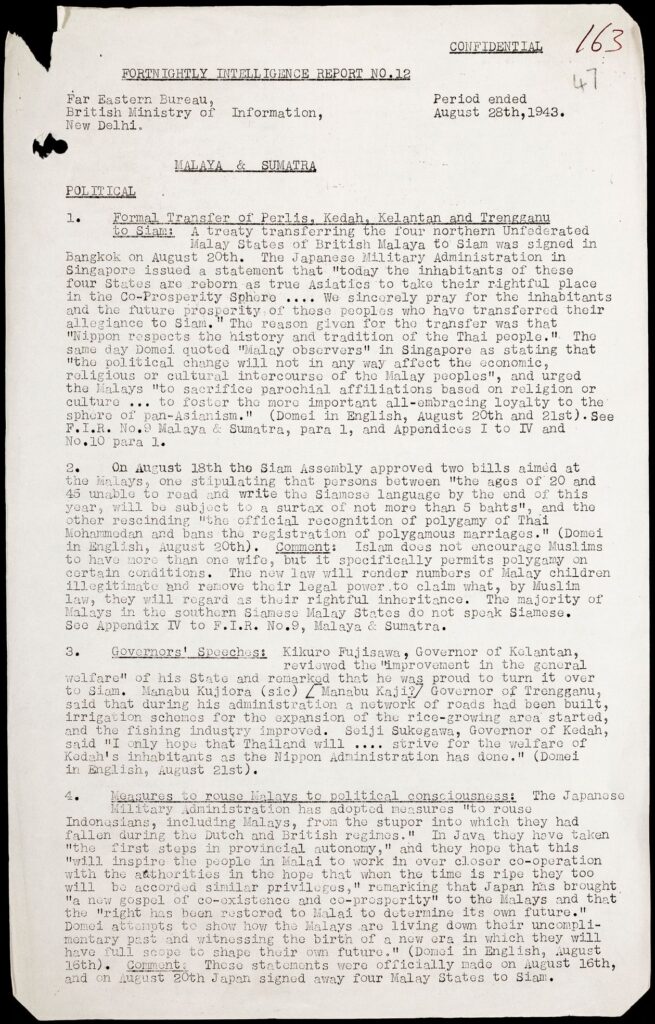
There are also letters describing the atrocities committed by the Japanese to Malayans at the beginning of the occupation.
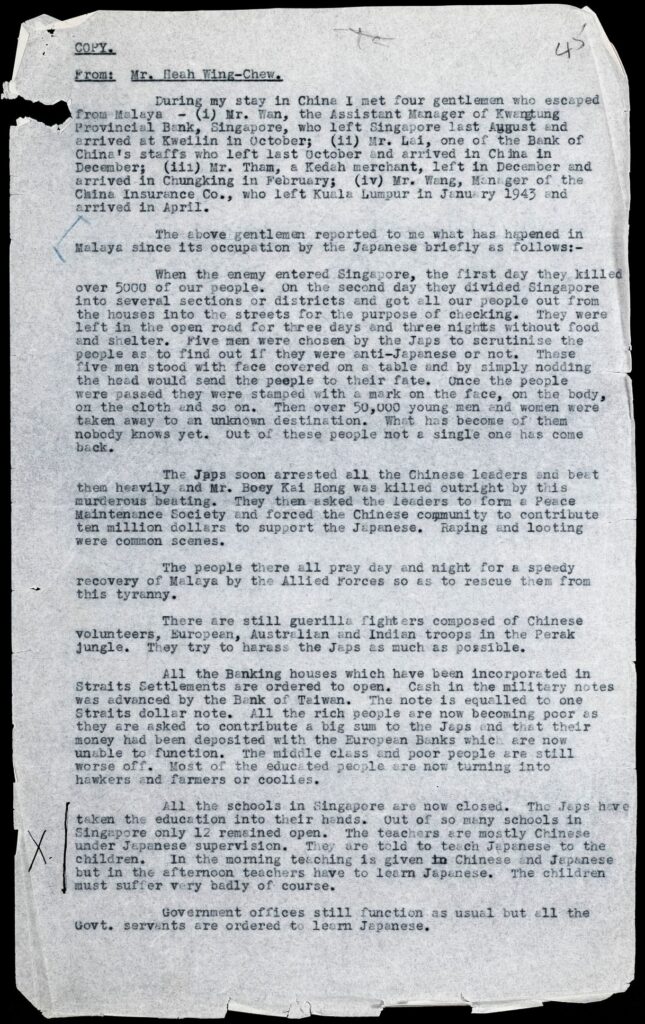
Another interesting topic featured is the anti-British Indian National Army that sought to overthrow the British colonial rule with Japanese assistance. The army consisted of a women’s regiment called the Rani of Jhansi regiment.
UK-Malaya Trade
Trade between Malaya and the UK is another main topic covered in Part III. Below is a despatch from H.M. Trade Commissioner in Singapore, analysing the decline of British cotton imports into the Federated Malay States in the early 1930s, and attributing it to the competition of cheaper Japanese cotton goods.
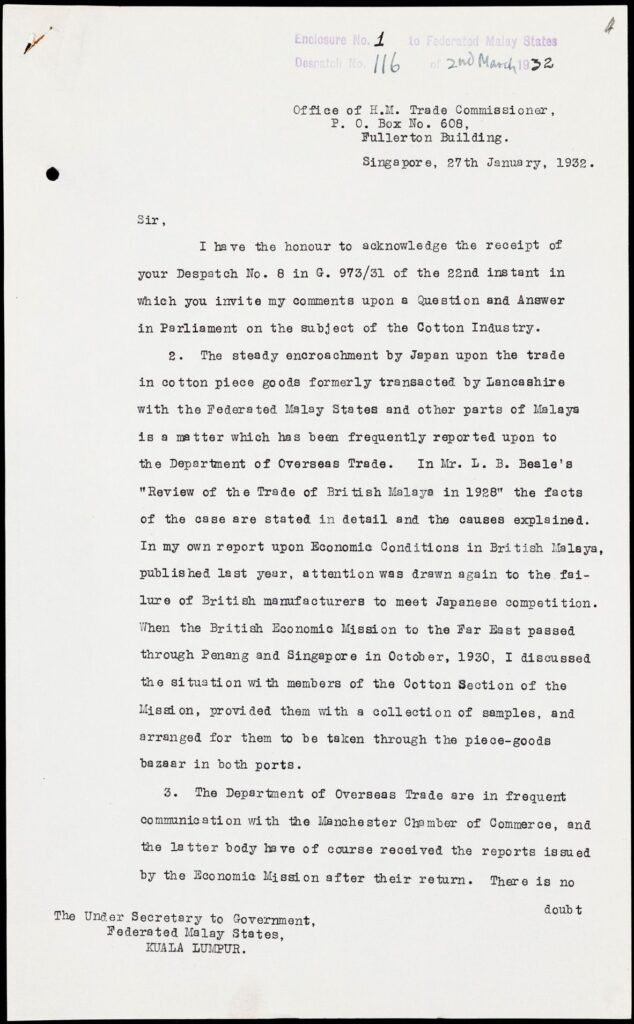
Feedback on the Federation Constitution
Part III includes a Colonial Office series (CO 889) dedicated to the Constitutional Commission (Reid Commission) which was assembled in London in 1956 to draft the Constitution of the Federation of Malaya prior to its independence. The series contains correspondence from associations and individuals with regard to their opinions on the Constitution.
Below is a letter in Chinese and English from the chairman of the Federated Teochew Association of Malaya, in which he argued for the “rights and privileges which the Chinese [in Malaya] ought to enjoy” given their “meritorious service . . . in the development and construction of the country.”
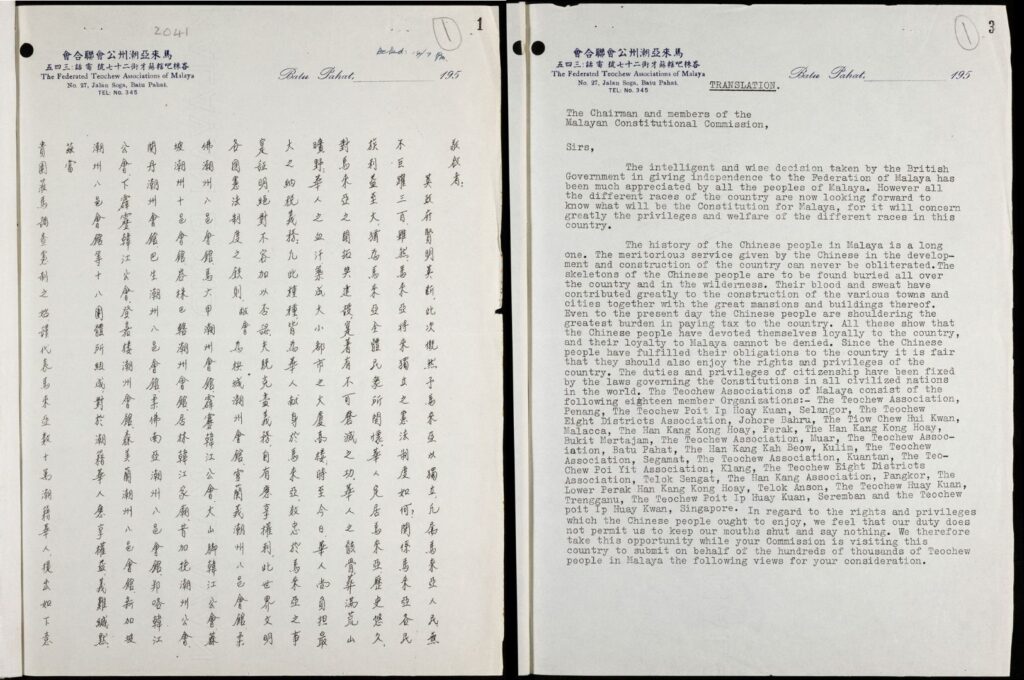
Interestingly, CO 889 also contains a valuable historical document titled “Tasks Ahead,” which is described as the People’s Action Party manifesto. The People’s Action Party has been the ruling party of Singapore since the 1950s and one of its founders, Mr. Lee Kuan Yew, was the first prime minister of the country, and his signature appears at the end of this manifesto.
The document analysed the political situation of Malaya, set out the party’s tasks, and declared: “For the first time in hundreds of years the peoples of Asia with their ancient cultures and civilisations have shaken off the humiliating shackles of European domination and exploitation, and are taking their places as equals in the comity of nations.” Such anti-colonial and -imperialist rhetoric cannot be more characteristic of the trends in Asia and Africa during the 1950s and 1960s.
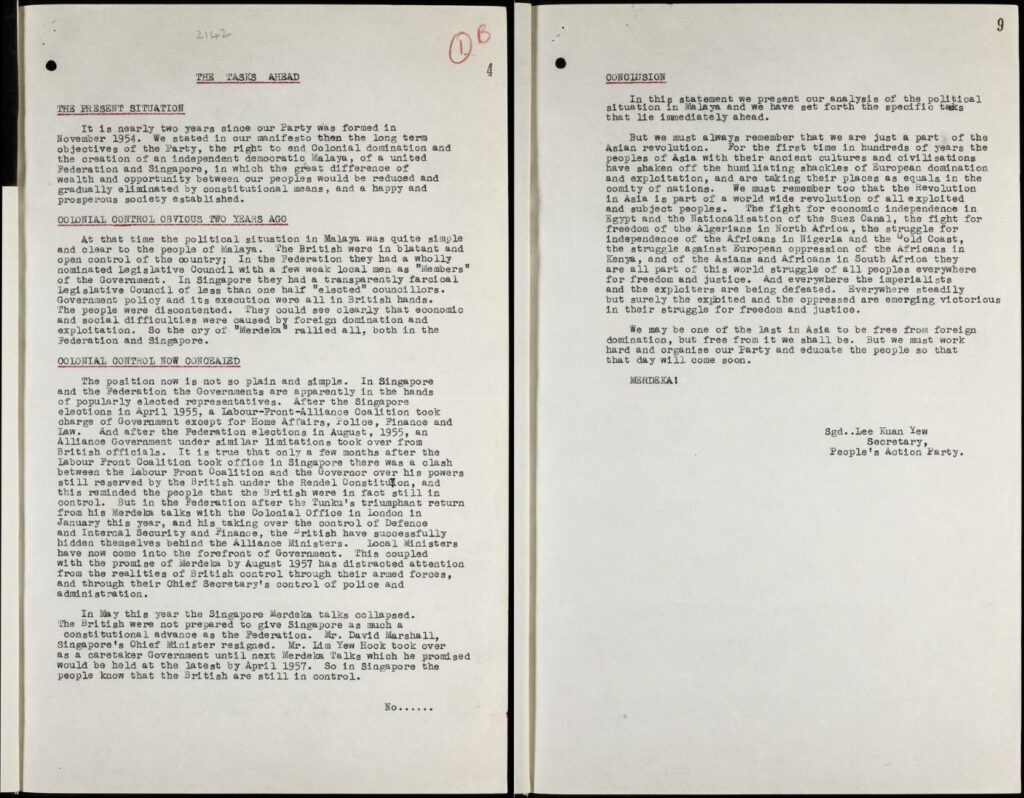
Communist Activity in Malaya
The Colonial Office files are ripe with material on communist activities in Malaya, led by the Malayan Communist Party. The CO 1022 series includes files on the case of Lee Tian Tai, a girl from Ipoh, who was charged and arrested for the “unlawful possession of arms.” Lee Tian Tai was also known as Lee Meng, a well-known Malaysian Chinese communist guerilla who was a leading member of the Communist Party of Malaya and gained a reputation for her fighting.
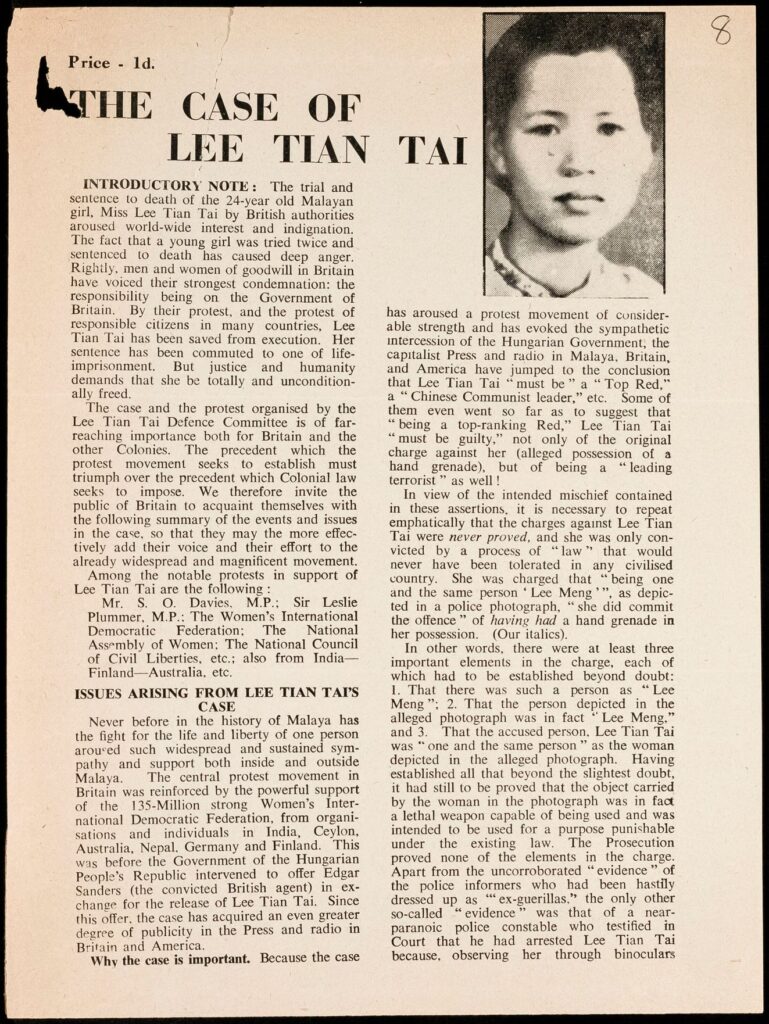
Her trial garnered wide international media attention – partly due to mistrust in the charges against her and during her trial. Although she was sentenced to death for her role in issuing a number of murders, several petitions led to her being spared and imprisoned instead. Lee Meng’s activities feature in several files, particularly weekly and monthly political intelligence and security reports.
Maps and Photographs
Much like the previous two modules, Part III includes series of maps, plans, and photographs which offer further insight into the changing territories and experiences of individuals living in the regions covered in this module.
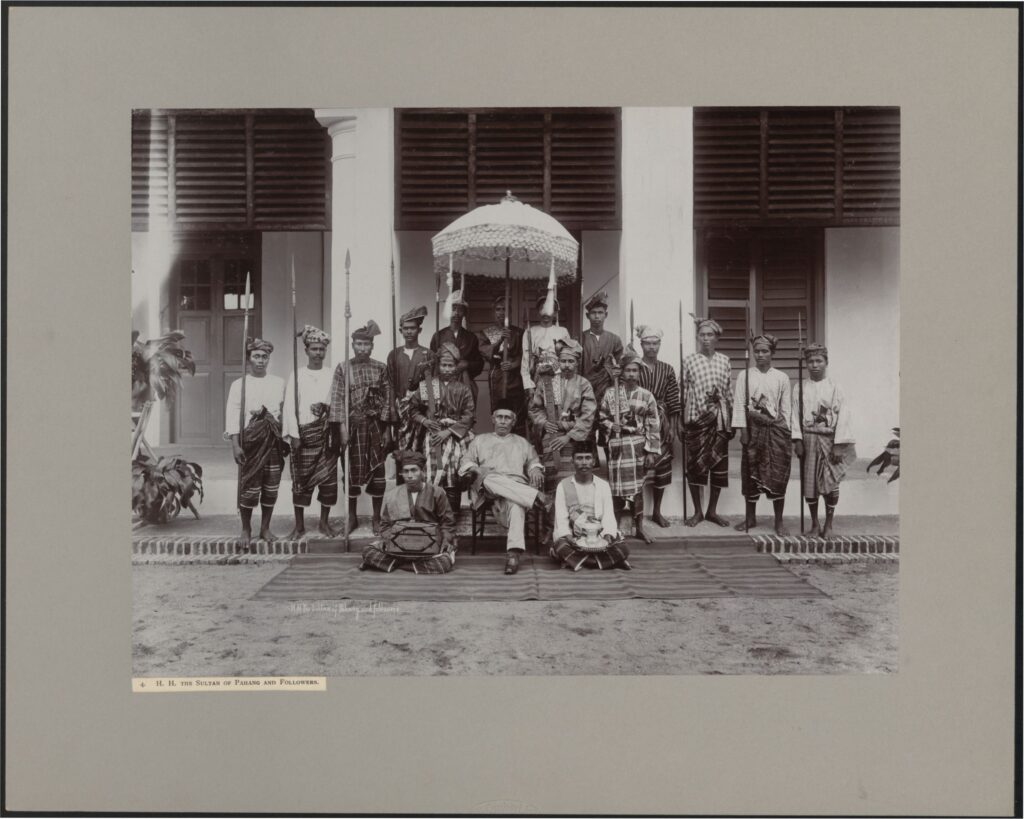
Within the photographic series (CO 1069), one can find photographs of key individuals, such as the Sultan of Pahang, as seen above, and symbols of British colonial rule like soldiers’ blocks, government houses, and post offices. A key feature of the photographs is their item-level metadata that makes finding relevant photographs easier for researchers.
Importance and Value
State Papers Online Colonial: Asia, Part III presents an archive of rare and invaluable British government records that document the history of Singapore and West Malaysia as British colonies from the early nineteenth century to the 1960s. It supports a wide range of research and teaching topics, including the history of Southeast Asia, the British Empire and Colonialism, Nationalism, communism, post-colonialism, the history of trade and commerce, and the WWII Asian theatre.
If you enjoyed reading this blog, then check out some of our other posts:
- Exploring the State Papers Online Colonial module about Singapore, East Malaysia, and Brunei
- Asia, as Recorded in British Colonial Office Files
- Decolonisation in the British Empire in Asia: The Malayan Emergency and Singapore
Blog post cover image citation: Straits Settlements. Singapore Strait, by Staff Commander J. W. Reed, H.M.S. Rifleman, and others, 1865-69, with additions from the latest British and Dutch authorities. Author, Publisher, &c.: Admiralty (No. 2,403) London. 1906. TS Records of the British Colonial Office CO 700/Straits Settlements 48. The National Archives (Kew, United Kingdom). State Papers Online Colonial, https://link.gale.com/apps/doc/BYIMGD223321998/SPOC?u=webdemo&sid=bookmark-SPOC&xid=3cdea989.


